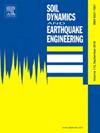A novel strength-based liquefaction triggering criterion based on degradation mechanism of secant shear modulus
IF 4.2
2区 工程技术
Q1 ENGINEERING, GEOLOGICAL
引用次数: 0
Abstract
There are currently two main criteria to identify the triggering time of soil liquefaction, namely when the excess pore water pressure reaches vertical effective overburden stress or the double-amplitude axial strain reaches 5 %. However, several researchers have pointed out that the excess pore water pressure may not reach confining pressure at some certain conditions, and the cycle numbers reaching liquefaction obtained by adopting two criteria for calcareous sand specimens are inconsistent, which may lead to overestimation or underestimation of the liquefaction resistance of calcareous sand. Therefore, this study introduces a parameter with physical meaning, secant shear modulus to evaluate the liquefaction potential of soil. To do that, a series of undrained shear tests were conducted on three types of sand. Firstly, the experimental results demonstrated that the difference in cycle numbers to liquefaction obtained by the two criteria increases with the increase of relative density. In addition, the study found that the degradation law of secant shear modulus with the number of cycles is not affected by loading conditions, initial state of soil, and soil type. On this basis, based on the relationship between secant shear modulus gradient and pore pressure ratio, it is highlighted that the liquefaction process can be quantitatively divided into three stages and the moment of liquefaction triggering can be correctly identified. Finally, the proposed liquefaction criterion is compared with widely used traditional criteria and latest apparent viscosity-based criterion, and the results showed that the liquefaction resistance obtained by the proposed criterion was more conservative, which benefits for reducing the occurrence of large strain development.
基于秒剪模量退化机制的新型基于强度的液化触发标准
目前确定土壤液化触发时间的标准主要有两个,即超孔隙水压力达到竖向有效覆盖层应力或双幅轴向应变达到5%。然而,一些研究人员指出,在某些特定条件下,超孔隙水压力可能达不到围压,并且采用两种准则对钙质砂试样得到的达到液化的循环次数不一致,这可能导致对钙质砂抗液化能力的高估或低估。因此,本研究引入一个具有物理意义的参数——割线剪切模量来评价土壤的液化潜力。为此,对三种类型的砂进行了一系列不排水剪切试验。实验结果表明,两种准则得到的液化循环数差值随相对密度的增大而增大。此外,研究发现割剪模量随循环次数的退化规律不受加载条件、土体初始状态和土体类型的影响。在此基础上,基于切线剪切模量梯度与孔隙压力比的关系,强调了液化过程可定量划分为三个阶段,并可正确识别液化触发时刻。最后,将所提出的液化准则与广泛应用的传统准则和最新的基于表观粘度的准则进行了比较,结果表明,所提出的准则获得的液化阻力更为保守,有利于减少大应变发展的发生。
本文章由计算机程序翻译,如有差异,请以英文原文为准。
求助全文
约1分钟内获得全文
求助全文
来源期刊

Soil Dynamics and Earthquake Engineering
工程技术-地球科学综合
CiteScore
7.50
自引率
15.00%
发文量
446
审稿时长
8 months
期刊介绍:
The journal aims to encourage and enhance the role of mechanics and other disciplines as they relate to earthquake engineering by providing opportunities for the publication of the work of applied mathematicians, engineers and other applied scientists involved in solving problems closely related to the field of earthquake engineering and geotechnical earthquake engineering.
Emphasis is placed on new concepts and techniques, but case histories will also be published if they enhance the presentation and understanding of new technical concepts.
 求助内容:
求助内容: 应助结果提醒方式:
应助结果提醒方式:


